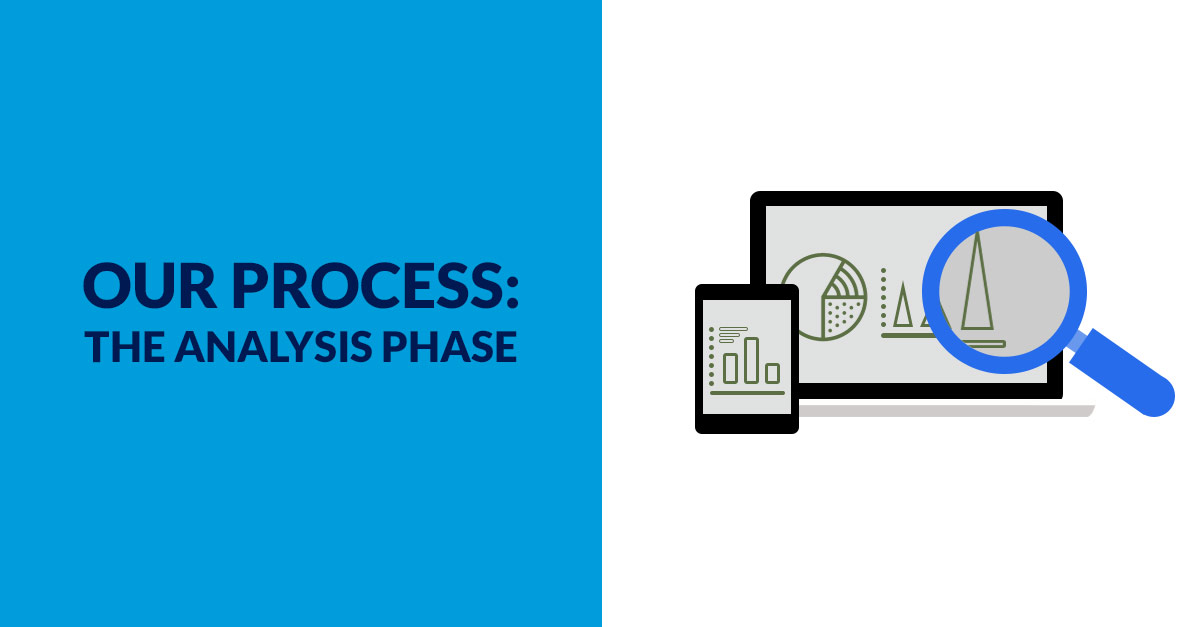
In our previous post you learned about how we bid projects and why it’s important to us to keep the process as honest and straightforward as possible.
This week, we’ll take a deep dive into the analysis phase.
The Analysis Phase
The analysis phase is our opportunity to dig into the details of your project so we can begin designing the right solution. The primary objectives of this phase are:
- Reducing risk by increasing our understanding of the project goals, users, processes, and features, and determining the right technology for solving the problem
- Prioritizing what to develop so we deliver the highest value features first
- Validating the chosen technology and/or architecture
- Confirming the expected investment and timeline so you know what to expect
The tools used in this phase can vary from project to project, but in general, the process looks something like this.
Internal Kickoff
It all starts with an internal kickoff meeting with our team. This is where we transfer any knowledge from the business strategist and lead developer who were involved in the proposal process to the rest of the project team.
We introduce you (figuratively) to the team by describing your company or organization, your business goals, customers, target audience, and what makes you stand out from your competition.
Then we delve into the project by sharing where you currently are and where you want to be (the goals of the project), and provide details like who the users of the system will be and a high-level view of the functionality to be developed. We share expected timelines and any associated constraints, and we give the team the opportunity to ask questions.
Project Kickoff
In the project kickoff, we introduce you—literally this time—to the people you’ll work with throughout the analysis phase. With the whole project team together, we review project goals, functionality, users and their associated permissions, any technical constraints or needs, and initial budget estimates and timelines. We’ll confirm user interviews to be done and talk through any technical proof-of-concept work needed.
We also use this time to set expectations, walk through communication and meeting schedules, and answer any questions you have about the project.
Coming out of this meeting, you’ll know when you’ll hear from us next, what we need from you, and what our next steps are.
Analysis Work & Deliverables
While every project is different, the work performed in the analysis phase is all focused on meeting the objectives identified above. In this phase, we usually do some combination of the following:
- Identify guiding principles for the project that help keep everyone on the same page and provide a roadmap for decision-making during the project
- Conduct user interviews and analyze the resulting data to better understand the perspectives of the people who will actually use the software
- If appropriate, do a buy vs. build analysis for all or parts of the application
- Create a concept model that represents the system and how different pieces relate to each other
- Create workflow diagrams for relevant processes to help us understand how different functions should be designed
- Create an information architecture diagram that shows the content and flow of information in the system
- Outline role definitions that identify which users can access which functions within the application
- Determine the technical architecture that will best meet the needs of the solution
- Perform any necessary technical analysis and/or proof-of-concept work
- Create and validate wireframe designs to ensure the layout and flow of the application are intuitive and easy to use
Based on the results of work above, we create a backlog of user stories—the requirements of the system—and estimate the effort to complete the stories. Because we know more at the end of the analysis phase than we did during the bidding process, this backlog allows us to estimate the total investment and timeline more accurately.
Finally, from this backlog of user stories, we create an initial release plan that shows the priority of functionality to be developed and the expected timeline for completion of each release.
Your Involvement
You’re involved throughout the analysis phase as we meet weekly to show you what we’ve done and plan the work that comes next. You help us identify users to interview; review concept models, workflow diagrams, and wireframes; and provide feedback to help us refine them. We generally have lots of questions for you and you’ll probably have some for us, so we communicate a lot—both in weekly meetings and via our client collaboration tool, Basecamp. Once we’re comfortable that the deliverables accurately represent the system and functionality, we ask you to sign off on them and work with us to prioritize the features so we can begin planning the development phase.
Setting the Foundation
By the end of the analysis phase, we have a strong foundation and a roadmap for the next phase—development.
We’ll dig in to the details of the development phase next time. In the meantime, if you have questions about our processes or a project you want to talk about,
reach out.